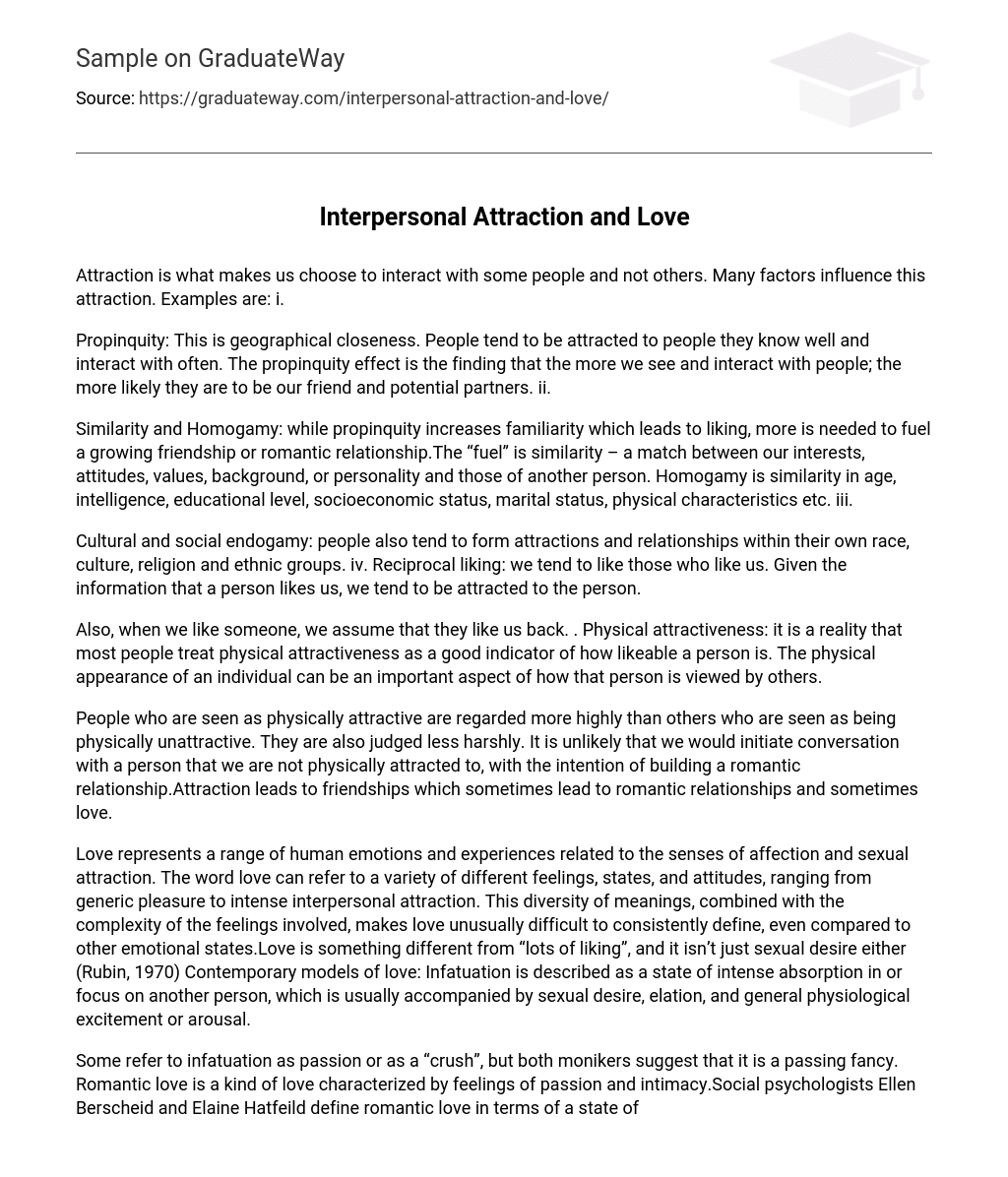Attraction is what makes us choose to interact with some people and not others. Many factors influence this attraction. Examples are: Propinquity: This is geographical closeness. People tend to be attracted to people they know well and interact with often. The propinquity effect is the finding that the more we see and interact with people; the more likely they are to be our friend and potential partners. Similarity and Homogamy: while propinquity increases familiarity which leads to liking, more is needed to fuel a growing friendship or romantic relationship.The “fuel” is similarity – a match between our interests, attitudes, values, background, or personality and those of another person. Homogamy is similarity in age, intelligence, educational level, socioeconomic status, marital status, physical characteristics etc.
Cultural and social endogamy: people also tend to form attractions and relationships within their own race, culture, religion and ethnic groups. iv. Reciprocal liking: we tend to like those who like us. Given the information that a person likes us, we tend to be attracted to the person. Also, when we like someone, we assume that they like us back. . Physical attractiveness: it is a reality that most people treat physical attractiveness as a good indicator of how likeable a person is. The physical appearance of an individual can be an important aspect of how that person is viewed by others. People who are seen as physically attractive are regarded more highly than others who are seen as being physically unattractive. They are also judged less harshly. It is unlikely that we would initiate conversation with a person that we are not physically attracted to, with the intention of building a romantic relationship.Attraction leads to friendships which sometimes lead to romantic relationships and sometimes love.
Love represents a range of human emotions and experiences related to the senses of affection and sexual attraction. The word love can refer to a variety of different feelings, states, and attitudes, ranging from generic pleasure to intense interpersonal attraction. This diversity of meanings, combined with the complexity of the feelings involved, makes love unusually difficult to consistently define, even compared to other emotional states.Love is something different from “lots of liking”, and it isn’t just sexual desire either (Rubin, 1970) Contemporary models of love: Infatuation is described as a state of intense absorption in or focus on another person, which is usually accompanied by sexual desire, elation, and general physiological excitement or arousal.
Some refer to infatuation as passion or as a “crush”, but both monikers suggest that it is a passing fancy. Romantic love is a kind of love characterized by feelings of passion and intimacy. Social psychologists Ellen Berscheid and Elaine Hatfeild define romantic love in terms of a state of intense physiological arousal and the cognitive appraisal of that arousal as love. The perception that one has fallen in love is derived from several simultaneous events: a state of intense physiological arousal that is connected with an appropriate love object (that is, a person, not an event) a cultural setting that idealizes romantic love, and the attribution of the arousal to feelings of love towards the person.Styles of love: Some psychologists speak in styles of love. Clyde and Susan Hendrick (1986) developed a love attitude scale that suggests the existence of six styles of love among college students: 1. ) Romantic love (Eros): Each partner fits the other’s ideal. There was an immediate attraction. ) Game – playing love (Ludus): The commitment in this case is not serious, and the love affair is gotten over easily. Friendship (Storge, Philia): This style of love suggests that the best love grows out of an enduring friendship.
Logical love (Pragma): A person considers a lover’s potential in life before committing themselves, for example, whether they would be a good parent.5. ) Possessive, excited love (mania): People who have this style of love get so excited about their love that it disrupts their normal lives. 6.
) Selfless love (agape): The person would do anything they can to help their lover, they place their lover’s needs and wishes as more important than their own. Some psychologists have recognized that a good definition of love must include he passionate, giddy feelings of romantic love as well as the deep, long – term devotion of a long – married couple, lifelong friends, or siblings. Other types of love are companionate and passionate love. Companionate love is the intimacy and affection we feel when we care deeply for a person but do not experience passion or arousal in the person’s presence.
Passionate love is an intense longing we feel for a person, accompanied by physiological arousal; when our love is reciprocated, we feel great fulfillment and ecstasy, but when it is not, we feel sadness and despair.Sternberg’s Triangular Theory of Love: Psychologist Robert Sternberg (1986, 1987, 1988) offers a triangular theory of love. In his view, love has three different components: Intimacy: the experience of warmth towards another person that arises from feelings of closeness, bondedness, and connectedness to the other.





